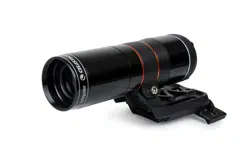Loading ...
Loading ...
Loading ...

6 | ENGLISH
Other Functionality
You can access all the additional options below by pressing the MENU
button, using the SCROLL keys to select “SSAG,” and pressing ENTER.
Refer to Fig. 13 for the SSAG menu tree.
PRECISE GOTO
PLATE SOLVE
CENTER CALIBRATE
POLAR ALIGN
GUIDING
VERSION
SETTINGS
FACTORY RESET
SSAG
Fig. 13: The SSAG menu tree in the NexStar+ hand control.
Precise GoTo
Precise GoTo uses SSAG to more accurately center objects in the
fi eld of view. When this option is enabled, the telescope mount uses
its internal alignment model to fi nd and center the object as usual; this
should generally place the object somewhere in the fi eld of view. Then
SSAG takes over, making fi ne corrections to the centering, signifi cantly
improving the overall pointing accuracy. When you are using SSAG,
Precise GoTo is enabled by default, so you do not need to initiate a
Precise GoTo here. However, if you have turned Precise GoTo off (see
Settings section below), you can initiate a Precise GoTo to a specifi c
object from this menu selection.
Plate Solve
When you choose this option, SSAG will capture an image and plate
solve. The hand control will display the center coordinates (RA and Dec)
to which the telescope is pointing in the sky.
Version
Selecting this option displays the current version number of SSAG’s
internal software.
• To view the NexStar+ hand control fi rmware version, select the “Version”
option from MENU>Utilities.
Settings
Use Precise GoTo – This setting allows you to enable or disable
automatic Precise GoTo after every slew. Precise GoTo is on by default for
the best pointing accuracy. However, this feature causes the telescope
to take slightly longer to center objects. We recommend that most users
leave Precise GoTo on.
Factory Reset
A factory reset power cycles SSAG and clears the device of any previous
center calibration data. When you turn on SSAG after a Factory Reset,
it will automatically initiate a new center calibration after sky alignment.
5. Using SSAG with CPWI
If you already use a PC to control your telescope (e.g., for astroimaging),
Celestron’s free CPWI software is a great way to control SSAG. Its
intuitive user interface makes accessing all of SSAG’s features easy.
mount’s position doesn’t need to be perfect. Aim within about
5° due North so the mount is within the range of the mount’s
azimuth fi ne adjustment knobs. Use a free compass app for your
smartphone if you need help fi nding North.
d. If you loosened the altitude or azimuth adjustment knobs during
rough polar alignment, make sure they are retightened before
continuing.
2. Press the MENU button and use the SCROLL keys to navigate to the
SSAG menu. Then press ENTER.
3. Use the SCROLL keys to select “Polar Align.” Press ENTER.
4. The hand control will ask you to slew the telescope to a clear area
of the sky. Use the hand control’s direction keys to point to a clear
location. Press ENTER.
• The telescope will slew from West to East for about 50° during the
polar alignment process. Try to choose a clear area that provides
a clear path.
5. The telescope will slew from West to East to obtain polar alignment
references. This will take a few minutes.
6. When the telescope stops slewing, the hand control will display
“Adjust AZM.” Press ENTER. The LCD will now show the AZM and
ALT polar alignment errors.
7. If your mount has an azimuth axis lock knob or locking screws, loosen
them before adjusting the azimuth.
8. Use the mount’s azimuth fi ne adjustment knobs to adjust the
mount’s azimuth (left-to-right) positioning slowly. As you make these
adjustments, the AZM error will increase or decrease. Continue
adjusting until the AZM error is below two arcminutes. Press ENTER.
• Do not adjust the altitude of the mount! You will make altitude
adjustments in the next step.
• Make the adjustments slowly so SSAG can track them. If you
adjust too quickly and SSAG loses track, you’ll need to restart the
entire polar alignment process.
9. The hand control will now display “Adjust ALT.” Press ENTER.
10. If your mount has altitude axis lock knobs, loosen them before
adjusting altitude.
11. Use the mount’s altitude fi ne adjustment knobs to adjust the mount’s
altitude (up-and-down) positioning slowly. As you make these
adjustments, the ALT error will increase or decrease. Continue
adjusting until the ALT error is below two arcminutes. Press ENTER.
• Do not adjust the azimuth of the mount.
12. The hand control will now ask, “Fine Adjust AZM?”
a. If you wish to make additional adjustments to the azimuth, use the
SCROLL keys to select “Yes” and press ENTER. Adjust until the
error is less than two arcminutes, and press ENTER.
b. If you do not want to make further adjustments, use the SCROLL
keys to select “No” and press ENTER.
13. Congratulations! You have successfully polar-aligned your mount. If
your mount has altitude or azimuth locking knobs or screws, tighten
them fi rmly. For best results, do sky alignment after polar alignment.
If you have already done a sky alignment, then we recommend power
cycling and performing sky alignment again.
NOTE: Don’t attempt to adjust the polar alignment to better than two
arcminutes on each axis. Doing so will be diffi cult and will not
provide additional pointing or tracking benefi ts. In many cases,
autoguiding performance may actually be better with a slight polar
alignment error.
Loading ...
Loading ...
Loading ...
